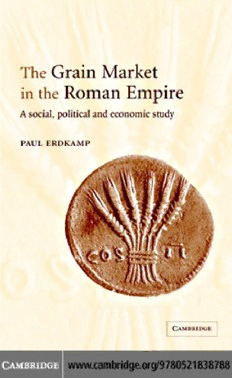
The grain market in the Roman Empire PDF
Preview The grain market in the Roman Empire
This page intentionally left blank ii xii THE GRAIN MARKET IN THE ROMAN EMPIRE This book explores the economic, social and political forces that shaped the grain market in the Roman Empire. Examining studies on food supply and the grain market in pre-industrial Europe, it addresses questions of productivity, division of labour, market rela- tionsandmarketintegration. Thesocial andpoliticalaspects of the Roman grain market are also considered. Dr Erdkamp illustrates how entitlement to food in Roman society was dependent on rela- tions with the emperor, his representatives and the landowning aristocracy, and local rulers controlling the towns and hinterlands. He assesses the response of the Roman authorities to weaknesses in thegrainmarketandlooksattheimplicationsofthefailureoflocal harvests.Byexaminingthesubjectfromacontemporaryperspective, this book will appeal not only to historians of ancient economies, but to all concerned with the economy of grain markets, a subject whichstill resonates today. paul erdkamp is Research Fellow in Ancient History at Leiden University. He is the author of Hunger and the Sword. Warfare and food supply in Roman Republican wars (264–30 bc) (1998). He is the editor of The Roman Army and the Economy (2002) and The Companionto the RomanArmy (forthcoming). THE GRAIN MARKET IN THE ROMAN EMPIRE A social, political and economic study PAUL ERDKAMP cambridge university press Cambridge,NewYork,Melbourne,Madrid,CapeTown,Singapore,SãoPaulo Cambridge University Press TheEdinburghBuilding,Cambridgecb22ru,UK PublishedintheUnitedStatesofAmericabyCambridgeUniversityPress,NewYork www.cambridge.org Informationo nthi stitle :www.cambri dge.org/9780521838788 © Cambridge University Press 2005 Thispublicationisincopyright.Subjecttostatutoryexceptionandtotheprovisionof relevantcollectivelicensingagreements,noreproductionofanypartmaytakeplace withoutthewrittenpermissionofCambridgeUniversityPress. Firstpublishedinprintformat 2005 isbn-13 978-0-511-13494-4 eBook(EBL) isbn-10 0-511-13494-0 eBook(EBL) isbn-13 978-0-521-83878-8 hardback isbn-10 0-521-83878-9 hardback CambridgeUniversityPresshasnoresponsibilityforthepersistenceoraccuracyofurls forexternalorthird-partyinternetwebsitesreferredtointhispublication,anddoesnot guaranteethatanycontentonsuchwebsitesis,orwillremain,accurateorappropriate. Contents List of maps page vii Acknowledgements viii Introduction 1 1 Production and productivity in Roman agriculture 12 Meansofproduction 14 Tenancy:capital,landandlabour 23 Yield,productivityandagriculturalsurplus 34 Conclusions 54 2 The world of the smallholder 55 Introduction 55 Definitionofapeasant 56 Householdandlabour 61 Alternativestrategies 79 Householdgoalsandthemarket 95 3 Farmers and their market relations 106 Introduction 106 Farmersandtheconsumermarket 109 Theadvancesaleofgrain,wineandoliveoil 120 Peasantsandthegrainmarket 134 Conclusions 141 4 Market integration: connecting supply and demand 143 Introduction 143 Marketingintime 147 Marketingacrossspace 175 5 Rome and the corn provinces 206 Introduction 206 Sicily 209 Taxation-in-kind 219 v vi Contents Egypt 225 ThecityofRome:the‘two-tiersystem’ 237 6 Urban food supply and grain market intervention 258 Introduction 258 Municipalgrainfunds 268 MarketregulationandpricefixingintheRomanworld 283 Benefitsforaprivilegedfew? 306 Conclusions 317 References 331 General index 356 Index locorum 363 Maps 1 Asia Minor page ix 2 Greece x 3 Italy xi 4 The Roman World xii 5 Egypt xiv vii Acknowledgements It is with much pleasure that I thank all those who have helped with the publication of this book, and with the research that preceded it. I am particularlygratefultothosescholarswhohavecourteouslyofferedassist- ance and read the manuscript in its entirety or in part: Lukas de Blois, LuukdeLigt,H.W.Pleket,JohanStrubbeandHansTeitler.Inaddition, I have benefited from comments made at presentations of parts of this book at workshops of the International Network Impact of Empire and other conferences held at the universities of Amsterdam (VU), Leiden, Nijmegen and Nottingham. I also thank the anonymous readers of the CambridgeUniversityPressfortheirvaluablecommentsandconstructive criticism. Very many thanks are owed to David Noy for reading through the entire manuscript with an eye for error and inconsistency that was greatly appreciated. Naturally, I alone am responsible for all flaws in the final version. I am grateful to Michael Sharp and Sine´ad Moloney for theirhelpandadviceingettingthisbookpublished.Finally,Iwouldlike to express my gratitude to Lukas de Blois and Theo Engelen for their unwavering support during these past years. I acknowledge with gratitude the funding of my research by the Netherlands Organisation for Scientific Research (NWO). viii
